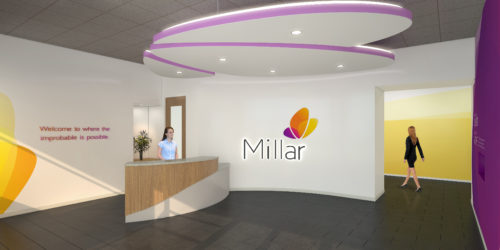In a segregated Washington, D.C. public school in 1897, teacher Mary Church Terrell took bold action. She persuaded the school board to set aside the afternoon of February 14 so she could honor the birthday of abolitionist Frederick Douglass and teach about his life and work. The event ignited momentum to expand the focus on Black history, and Gerald Ford in 1976 declared February Black History Month. Of the many notable Black architects in history, these achieved significant ‘firsts’: Moses McKissack III (1879-1952) together with his brother Calvin Lunsford McKissack (1890-1968), founded the nation’s first Black-owned architecture firm. McKissack & McKissack today is a continuation of that firm. Paul Revere Williams (1894-1980) was discouraged from studying architecture at Los Angeles' Polytechnic High School due to his race. He went on to graduate from the U. of Southern California School of Architecture. He was licensed as a California architect in 1921. In 1923 he became the first Black member of the American Institute of Architects (AIA). Beverly Lorraine Greene (1915-1957) earned a Bachelor of Architecture degree and Master’s degrees in both Architecture and City Planning. In 1942 she became the first Black woman licensed as an architect in the United States. John S. Chase (1925-2012) was the first Black student to earn a Master of Architecture degree from the U. of Texas and the first Black architect registered in the state of Texas. He was a co-founder of the National Organization of Minority Architects (NOMA) in 1971. In 1980, he was the first Black appointee to the U.S. Commission on Fine Arts. Norma Merrick Sklarek (1926-2012) has been called the Rosa Parks of architecture. She was the first Black woman to become a licensed architect in both New York (1954) and California (1962). She was also the first Black woman to become a member of the AIA in 1959, and its first Black female fellow in 1980. Today, only 2% of licensed U.S. architects are Black. NOMA works nationally and in local chapters for the purpose of minimizing the effect of racism in architecture. Learn more about their work here at https://www.noma.net/about-noma
It’s been 15 years in the making and the planning is paying off. The Lower Kirby District continues to bring in new commercial development, snagging another company that opted to relocate their HQ to the growing master-planned district. Medical device manufacturer Millar, Inc. just broke ground on a 56,000 s.f. office and manufacturing facility. Millar is well known in the medical instrumentation industry for their innovative pressure sensor-enabled medical devices; Millar catheters have been hailed as “the gold standard.” PRISM worked directly with Millar to develop several exterior and interior renderings for promoting the project. The Pearland Economic Development (PEDC) extended Kirby Drive from Shadow Creek Ranch to Beltway 8 in 2006. This connection provided direct access to the 1,200-acre Lower Kirby District. It also provided more convenience for the large labor force located in Pearland. It was all part of the PEDC’s strategy to transform the vast tract of undeveloped property into the amenity-rich, multi-use destination that Lower Kirby District has become. Millar viewed the Lower Kirby District as the ideal location to support their long-term growth plans. The company chose Pearland and the Lower Kirby District specifically for their growing roster of life sciences specialty manufacturers located there. The new building is on a 5-acre site Millar purchased from PEDC. Clay Development and Method Architecture are providing architecture and interior design. The new building will house 120 employees and will have space for Millar’s research and development efforts, warehousing, manufacturing, and offices. Construction is expected to be complete in late 2022.
Pompano Beach, nestled on the Atlantic coast between Boca Raton and Fort Lauderdale, might not have the high profile of its neighbors – yet. The city has been attracting a slew of luxury oceanfront developments in the past decade. Developer Grover Corlew hopes to spur even more growth with their new multifamily property under the Mayla Residences’ brand, called Mayla Pompano. The two-building apartment complex will have 355 units, including 53 units dedicated to workforce housing. MSA Architects, Inc. designed the $78.2 million complex and brought in PRISM Renderings to generate several exterior renderings for project approvals and pre-leasing. Mayla Pompano is part of a larger plan by the Pompano Beach Community Redevelopment Agency to revitalize the East Atlantic Boulevard corridor. For Mayla Pompano, Grover Corlew is redeveloping a 3-acre site they own that is currently used for surface parking. MSA incorporated 60,000 s.f. of retail space on the ground floor of Mayla Pompano, fronted by wide pedestrian walkways. Residents will have access to a 2-story clubroom, coworking spaces, a dog spa, indoor bike storage and repair space, outdoor kitchens, and pools with cabanas. Apartments will have hurricane impact windows, walk-in closets, private balconies, and bathrooms with soaking tubs, frameless showers, and backlit vanity mirrors. Construction is expected to start in February and be complete in summer 2023.
2021, what a rebound! THANK YOU to our clients for making it a great year. We served 85 clients, 33 of them new! We produced renderings and animations for over 160 projects located in 10 states and 71 cities across the U.S., plus one in the Bahamas. We’re ready to step it up in 2022!
Project manager Lily Luo joined PRISM before Covid hit the U.S. Despite all the uncertainties of the past couple of years, she has remained a bright light. Always optimistic, always working to better herself – it’s no wonder our clients love her. And so do we! Cheers to three years!
Happy 1st anniversary to our multi-talented marketer Jill Solis. She dove in headfirst to learn everything about architecture, development, and construction and we are better for her efforts. Thank you for your constant motivation and willingness to push us forward.
Starbucks is on us! What do you want to see and read in our newsletter this year? The first 20 people to email Jing or Deborah with their input will receive a $10 Starbucks card. We’d really appreciate it if you would give us some feedback and help us add more value to our readers. Emails below:
Agape Development and Agape Homes CDC held a ribbon-cutting ceremony this past weekend to celebrate the completion of their first eight homes, located in the neighborhood south of the University of Houston called OST/South Union. PRISM is beyond blessed to be part of this life-giving project. Learn more about this project: https://new.prismrenderings.com/homes-for-all/
Financial analysts are split on their predictions about the 2022 economy. Fluctuation in supply chain bottlenecks and staffing issues, along with lingering COVID concerns, have only raised uncertainty. Prognosticators in real estate, design, and construction all see a positive year ahead. The AIA Consensus Construction Forecast has a generally positive outlook, predicting an increase in construction spending due to pent-up demand. Their estimate is a 4.6% increase in non-residential construction, with health care facilities expected to be the strongest performing sector, with a 1.4% increase. Across other sectors, industrial will likely lead the charge again in growth. The huge spike in shipping transportation costs will have companies looking for more warehousing space. Multifamily will be the contender for growth, with a projected capital investment of $234 billion. The lingering questions about how to bring employees back into the office will remain. Lease transactions are rebounding but office vacancy is expected to hit its highest level since 1993, due to 53M s.f. of new office construction hitting the market. Retail, and especially grocery-anchored centers, are expected to be strong this year due to the expected 20% growth in grocery-based e-commerce. Credit to CBRE for market data. All eyes will be intently monitoring spending under the Infrastructure Investment and Jobs Act. The $550 billion earmarked is spread across several major initiatives, ranging from public transit projects to climate resiliency projects. The Houston Ship Channel is already a big winner under the Act, recently receiving $142.5 million to deepen and widen the critical container channel.
One of PRISM’s newest clients, McCree General Contractors & Architects of Orlando, FL, has two significant projects underway. We are honored to be part of the fundraising effort for two new churches the firm designed and will be building. Just west of Orlando, Winter Garden, FL, sits on the shores of Lake Apopka. This small suburb is home to one of the oldest Lutheran churches in Florida, the Zion Evangelical Lutheran Church. The congregation began as a home church in 1885. By 1891, the church had grown and started a small school. During World War I, “Lutheran” became synonymous with “German” and Zion Church was targeted for hate crimes and was vandalized. The church remained true to their mission. Over the decades, the church grew and shrank, reorganized, and adopted the new slogan, “God’s Truth for You.” Zion Evangelical Lutheran Church is in growth mode again. PRISM developed renderings for their fundraising campaign for a new building. At a modest 9,125 s.f., it will house an altar, nave, narthex, and fellowship/bible study area. Construction will start in 2022. Stewart Neilson is the designer and Tom F. Griffin is the architect, both of McCree General Contractors & Architects. The same firm designed another small community church, the Heart of Mercy Church in Orlando, FL. The 2,400 s.f building is a new sanctuary and fellowship hall. It is currently in fundraising, using the rendering from PRISM to communicate the church vision and help with donations. Heart of Mercy Church is relatively new, opening in 2003. Their mission is clear, to offer a place for the children and families of the community to be the people God created them to be. Impactful is how we’d describe both of these projects. They both hold great opportunities for the people they will serve in the communities where they will be located.












